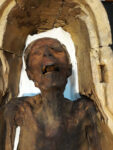 CT scans of a mummy dubbed the “screaming woman” due to her evocative open mouth have revealed that she died suddenly of a heart attack and the mummification process preserved her expression and posture at the moment of her death.
CT scans of a mummy dubbed the “screaming woman” due to her evocative open mouth have revealed that she died suddenly of a heart attack and the mummification process preserved her expression and posture at the moment of her death.
She was discovered in the late 19th century in the mortuary complex of Deir el-Bahari on the west bank of the Nile across Luxor. Her body was part of the Royal Cache, a tomb containing the remains of 40 royal mummies from the 17th through the 21st Dynasties. They were hidden there by 21st Dynasty priests to prevent them being pillaged by grave robbers. In an all-too-common irony, the Royal Cache was discovered in the early 1870s by a tomb robber whose family lived richly off the proceeds for years before the authorities busted them and found the tomb. Hieratic writing on her linen bandages identify her as “the royal daughter, the royal sister of Meret Amon.” It was a relatively common name among pharaonic princesses, so it’s unclear with Meret Amon from which dynasty she was.
Another individual found in the Royal Cache whose wide-open mouth earned him the matching monicker of the “screaming man” was recently discovered to be Prince Pentawere, son of King Ramses III. He was forced to hang himself after conspiring in the assassination of his father and was condemned to eternal punishment by being wrapped in sheep skin instead of embalmed and snugly swaddled with linen bandages.
 The screaming woman suffered no such ignominy. She was treated with the traditional care of royal mummification rituals, wrapped in linen and embalmed. Her position is unusual, however. While all the other respectfully mummified royalty in the cachette were positioned in solemn dignity with their jaws closed and their bodies straight, her head is turned to the right, her legs crossed at the ankle.
The screaming woman suffered no such ignominy. She was treated with the traditional care of royal mummification rituals, wrapped in linen and embalmed. Her position is unusual, however. While all the other respectfully mummified royalty in the cachette were positioned in solemn dignity with their jaws closed and their bodies straight, her head is turned to the right, her legs crossed at the ankle.
Egyptologist Zahi Hawass worked with Sahar Saleem, professor of radiology at Cairo University, to answer some of the questions about the screaming woman. They examined it with high-resolution CT scanner in Cairo’s Egyptian Museum. The scan found that she was in her 60s when she died and suffering from severe atherosclerosis, thick plaque deposits that collect inside arterial walls which restrict and ultimately block blood flow.
The CT scan showed that she suffered from atherosclerosis of the right and left coronary arteries, neck arteries, abdominal aorta and iliac arteries, as well as the arteries of the lower extremities.
Cardiac diseases, especially coronary artery disease, are the leading cause of sudden death in adults in the modern period.
It seems that the “screaming woman” died suddenly while in her current body posture, with flexed crossed legs. Consequent to death, her head was tilted to the right side and her jaw dropped.
“We assume that the dead body of ‘the screaming woman’ might not have been discovered until hours later, enough to develop rigor mortis,” said Hawass.
“We assume that the embalmers likely mummified the contracted body of the ‘screaming woman’ before it decomposed or relaxed. The embalmers were thus unable to secure the mouth closed or put the contracted body in the state of lying down, as was usual with the other mummies, thus preserving her facial expression and posture at the time of death,” he said.